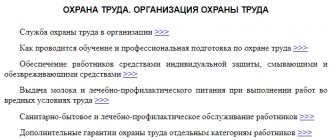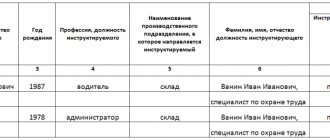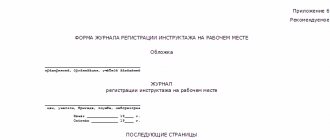Categories of workers exempt from on-the-job training
According to the Labor Code of the Russian Federation and the Procedure for Labor Safety Training, approved by Resolution No. 1/29, personnel not related to the operation, testing, adjustment and repair of equipment, the use of electrified and other tools, and the safety of raw materials and supplies may be exempt from undergoing initial training.
Automatically designated categories of employees are not exempt from initial training.
For release, a special order is issued at the enterprise.
When exempting staff from on-the-job training, the employer must understand that almost every employee uses office equipment and other electrical appliances for work, so there is always a threat that a person will receive an electric shock or other injury.
A training visa will reduce the liability of the company itself and its management in the event of an accident.
Therefore, before deciding to exempt employees from initial training, you should carefully assess the possible risks for the organization.
Who is entrusted with conducting repeated training at the workplace?
The immediate supervisor is responsible for informing and checking skills. This could be a teacher, an industrial training instructor, or a foreman. The choice of a specific option depends on the number of workers. Also, additional requirements may be imposed on certain categories of persons. For example, instructors must undergo training and testing of acquired knowledge in special specialized educational centers.
If the number of the enterprise exceeds 50 people, then individual specialists should be appointed or independent divisions should be organized. Up to 50 - the manager can personally deal with security issues, enter into agreements with specialized organizations, and assign them to employees.
Note! The training school can not only monitor the acquisition of knowledge, but also evaluate the quality of assimilation of the knowledge provided. In fact, it takes over all the tasks of specialists, outsourcing this area.
For whom is the passage mandatory?
According to Art.
212 of the Labor Code of the Russian Federation, the head of the company is obliged to ensure safety and conduct initial training for all personnel. According to Art. 225 of the Labor Code of the Russian Federation, all workers are obliged to undergo training in the field of labor protection.
However, if the enterprise has approved a list of positions exempt from training, employees may not undergo it.
It is impossible to include in such a list the professions and positions of workers directly related to production, equipment and materials (Article 212 of the Labor Code of the Russian Federation).
For example, weavers, molders, bakers, etc. Such positions are always associated with danger.
They require not only initial training at the workplace, but also repeated and unscheduled briefings.
admin wrote:
1. That’s it, in the first part it is written that “ may not be carried out.” And in order not to carry out it is necessary to approve the list of these positions and professions.
Right. If you have a list of professions and positions of employees that are exempt from initial training at the workplace and repeated training, then training is not carried out for them. If there is no such list, then confirm that it has been done.
2. Positions do not have occupational safety instructions and, accordingly, they do not need initial instruction. But there remain 2 repeated instructions mentioned above. Shouldn’t we make 2 lists for engineers and workers? 2) you reflected these questions in other documents, and the title of Chapter 4 \"Occupational Health Instruction\" of Resolution No. 175 does not fit here.
Even if issues of electrical safety and fire safety are reflected in other documents, then the requirements of MPOTE and clause 2.1.5 of NPB 1.01-94. Officials (specialists) may be given instructions. See Resolution No. 175: \»44. Specialists performing work in the professions of workers undergo training, instruction and testing of knowledge on labor protection issues in accordance with Chapter 2 of this Instruction.\"
As for the instruction for assigning electrical safety group I, then, based on the MPOTE, the availability of specific instructions, but usually such instructions are made. This instruction has a different character than instruction on occupational safety in the understanding of Resolution No. 175. As stated in the MPOTE: \»12. ... Electrical safety group I is assigned to non-electrical personnel associated with work, during which there may be a danger of electric shock.\" Considering this provision and paragraph 55 of Resolution No. 175, where instruction may not be carried out with persons who are not engaged in work on installation, operation, adjustment, maintenance and repair of equipment, use of tools, storage and use of raw materials (except for work with increased danger), it turns out that, for example, there is a kettle in the department, but this is not equipment in the sense of Resolution No. 175 ( this means production equipment), so employees of the department may not be given safety training. But there is a risk of electric shock, so the assignment of electrical group I should be.
As for fire safety training, according to PPB 1.01-94: \»2.1 At each enterprise, an order and general facility instructions must establish an appropriate fire safety regime, including: 2.1.5 The procedure and timing for completing fire safety training and the fire-technical minimum are determined (Appendix 2), and also the persons responsible for their implementation have been appointed.\" This briefing must be carried out in any case, although there may be a list of professions and positions of workers exempt from initial briefing at the workplace and repeated briefing.
conclusions
A number of points can be highlighted on this topic:
- Primary instruction takes place at the place of work of the person by the immediate superior.
- This type of training is required for all employees. An exception is for positions included in the list of the enterprise by special order and exempt from training.
- Art. 11 of the Labor Code of the Russian Federation exempts the management of companies from the obligation to provide instructions to employees working under civil law contracts (contracts).
- It is not recommended to release personnel, since in the event of an accident, all responsibility will fall on the employer.
Conducting refresher training for contractors
The legislative documentation does not stipulate who is obliged to carry out repeated training for employees of the involved organization. This should be decided on an individual basis between the client and the contractor. The legislation only stipulates induction training. The customer organization is obliged to do this.
Instructions before starting work
All other types of information and skills testing are usually carried out by the contractor. However, there are some nuances here. Since the contractor is carrying out work on the customer’s premises, it is necessary to monitor compliance with safety standards at the designated site, which includes undergoing repeated training.
“List 95” WHAT and based on WHAT - OCCUPATIONAL SAFETY
During the repeated fire safety briefing, knowledge of fire safety standards, rules, norms and instructions, the ability to use primary fire extinguishing equipment, knowledge of evacuation routes, fire warning systems and management of the evacuation process are tested. Repeated fire safety training can be combined with training of workers to provide first aid to victims, which is carried out in accordance with the joint Resolution of the Ministry of Labor and the Ministry of Education of January 13, 2003 N 1/29 “On approval of the procedure for training in labor protection and testing knowledge of labor protection requirements for workers organizations” at least once a year. It must be added to the above that the most dangerous factor for office workers is a personal computer. Working with it belongs to hazard class 3. Therefore, personnel working with PCs must undergo annual medical examinations. To reduce the impact of harmful factors from a PC (you can read about them in the section “Occupational safety when working with a PC” ), it is necessary to observe a work and rest regime.
Tags: office workers, initial training at the workplace, introductory fire safety training, working with a PC
1. Director.
2. Occupational safety specialist.
3. Employees performing work under the terms of an employment contract concluded for a period of up to two months.
4. Employees performing part-time work.
5. Workers not involved in the operation, maintenance, testing, adjustment and repair of equipment, the use of electrified or other tools, the storage and use of raw materials.
6. Workers not associated with work in dangerous and harmful working conditions.
5. Within what period is an employee who has not passed the test of knowledge of labor protection requirements during training required to undergo a re-test?
1. No later than three months.
2. No later than one month.
3. At the discretion of the manager.
6.
Who conducts the investigation of accidents involving students or students of educational institutions undergoing practical training in an organization under the guidance and control of a representative of the educational institution?
1. Conducted by a commission formed and headed by this employer, with the mandatory participation of representatives of the educational institution.
2. Conducted by a commission formed and headed by the head of the educational institution, with the mandatory participation of representatives of the organization.
3. Conducted by a commission formed by the employer and headed by a representative of the educational institution.
7. At what expense do employees undergo educational preliminary and periodic medical examinations?
1. At the expense of the employer.
2. At your own expense.
3. Preliminary - at your own expense, periodic - at the expense of the employer.
| Practical work 14 | |
| Question number | Correct answer |
Practical work No. 15
When does the employment contract come into force?
1. From the date of its signing.
2. From the day the employee is actually admitted to work.
3. From the date specified in the employment contract.
4. In all the above cases.
What is the duration of leave without pay for working disabled people?
1. Up to 14 calendar days.
2. Up to 35 calendar days.
3. Up to 60 calendar days.
Who is exempt from on-the-job training?
1. An employee who has worked in his specialty for at least 3 years.
2. An employee moving from one unit to another, if the nature of his work and the type of equipment on which he previously worked did not change.
3. An employee who has worked in his specialty for at least 3 years or an employee who moves from one unit to another, if the nature of his work and the type of equipment on which he worked previously does not change
.
4. An employee changing the qualification level required to perform a given job.
4. What is the time frame for special training on labor protection and testing of knowledge of labor protection requirements when entering work for workers in blue-collar professions?
1. During the first month
.
2. During the quarter.
3. During the probationary period.
5. Who conducts the investigation of accidents involving students or students of educational institutions undergoing productive practice in an organization under the direction and control of the employer?
1. Conducted by a commission formed and headed by the head of the educational institution, with the mandatory participation of representatives of the organization.
2. Conducted by a commission formed and headed by this employer, with the mandatory participation of representatives of the educational institution.
3. Conducted by a commission formed by the employer and headed by a representative of the educational institution.
What is the time frame for investigating occupational diseases?
1. Within 10 days from the date of receipt of notification of the final diagnosis of an occupational disease.
2.Within a month from the date of receipt of the occupational disease.
3. Within 10 days from the date of receipt of the order to create a commission to investigate the occupational disease.
What is the frequency of medical examinations?
1. Once a year.
2. At the discretion of the employer.
3. Depending on the degree of harmfulness and danger, the employer determines the frequency, but at least once every two years.
4. Once every two years.
CORRECT ANSWERS TO TEST No. 15+
| Practical work No. 15 | |
| Question number | Correct answer |
Practical work No. 16
How introductory briefing on labor protection is carried out
Inside, the sheet is lined into a table consisting of eight columns: Date Full name of the person being instructed Year of birth Profession, position of the person being instructed Name of the production unit to which the person being instructed Last name, initials, position of the person instructing Signature of the person being instructed Pay attention! The relevant information is entered into each column, and the entry is certified by both the inspected employee and the employee who conducted the induction training. In addition, information about the receipt of occupational health and safety instructions is included in the employment order and in the employee’s personal file. Storage period of the log and sample The storage of the log is assigned to the safety engineer or other employee performing this function on the basis of an order. The magazine's shelf life is 10 years.
Procedure for exemption from instruction
When organizing the exemption of employees of an enterprise from undergoing labor safety training, the following is necessary:
1. Determine (possibly according to the staffing table) a list of positions at the enterprise that are not related to the performance of the functions described in paragraph. OK. If you have been working in an organization for a long time, then this should not be a problem. To be more confident in the correct definition of positions, you can read the employee’s job description or talk with him or his manager.
Typically, this list includes positions of workers who work on computers - office workers.
2. We draw up an order to exempt employees from undergoing initial training at the workplace. This order must contain a list of positions exempt from training.
order
In addition to the note, I am enclosing the official clarification of the Ministry of Labor and Social Protection of the Russian Federation “On exemption from undergoing initial training at the workplace” No. 15-2 / OOG-1551
Download the letter
This letter clarifies that employees whose activities involve the use of personal computers and other office equipment may be exempt from undergoing on-the-job training. However, the list of workers’ data should be agreed upon with the trade union committee or occupational safety specialist.
The letter also states that for employees exempt from initial training at the workplace, repeated training will not be carried out.
Subscribe to our Youtube channel. There will be many interesting and useful videos!
Purpose of the enterprise
Induction training is carried out with:
- newly arrived (hired) employees,
- citizens who arrived at production as business travelers;
- employees carrying out their activities under a fixed-term or civil contract;
- persons transferred to another position within the same enterprise.
The purpose of conducting introductory training on labor protection is:
- informing the organization's employees about the features of the organization's production process, the technology and equipment used in order to avoid disruption of the process and equipment failure;
- preventing injuries at work and harm to production employees;
- prevention of the negative impact of the specifics of production (working with harmful and dangerous elements of production) on employees, thereby preventing injuries;
- peculiarity of working with hazardous substances and mechanisms.
To achieve these goals, responsible persons develop special induction programs taking into account the specifics of the enterprise and the characteristics of the production process. After development, the programs are approved by order.








